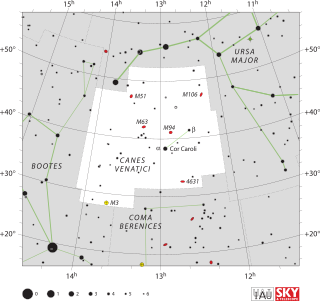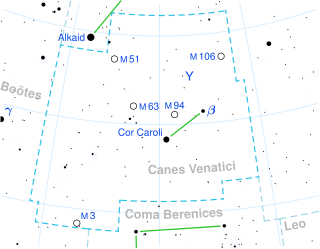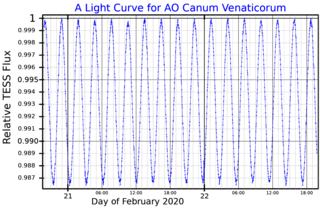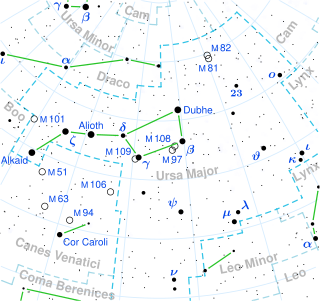Related Research Articles

Cor Caroli is a binary star designated Alpha Canum Venaticorum or α Canum Venaticorum. The International Astronomical Union uses the name "Cor Caroli" specifically for the brighter star of the binary. Alpha Canum Venaticorum is the brightest point of light in the northern constellation of Canes Venatici.
37 Geminorum is a solitary Sun-like star located at the northwest part of the northern constellation of Gemini, about three degrees to the east of the bright star Epsilon Geminorum. The apparent visual magnitude of 37 Geminorum is 5.74, which is just bright enough to be visible to the naked eye on a dark night. It is located at a distance of 57 light years from the Sun based on parallax. This star is drifting closer with a radial velocity of −15 km/s, and is predicted to come as near as 13.8 light-years in approximately a million years. It is positioned close enough to the ecliptic to be subject to lunar occultations, such as happened on April 8, 1984.

Beta Canum Venaticorum, also named Chara, is a G-type main-sequence star in the northern constellation of Canes Venatici. At an apparent visual magnitude of 4.25, it is the second-brightest star in the constellation. Based upon an annual parallax shift of 118 mas, this star is 27.6 light-years distant from the Sun.
24 Canum Venaticorum is a single star in the northern constellation of Canes Venatici, located 277 light years away from the Sun. This object is visible to the naked eye as a faint white-hued star with an apparent visual magnitude of +4.68. It is moving closer to the Earth with a heliocentric radial velocity of −18 km/s.

20 Canum Venaticorum is a single variable star in the northern constellation of Canes Venatici, located 238 light years from the Sun. This object has the variable star designation AO Canum Venaticorum; 20 Canum Venaticorum is the Flamsteed designation. It is visible to the naked eye as a faint, white-hued star with a baseline apparent visual magnitude of +4.72. The star is moving further from the Earth with a heliocentric radial velocity of +9 km/s. Eggen (1971) listed this star as a member of the Hyades Stream.

Nu Phoenicis is a F-type main-sequence star in the southern constellation of Phoenix. It is visible to the naked eye with an apparent visual magnitude of 4.95. This is a solar analogue, meaning its observed properties appear similar to the Sun, although it is somewhat more massive. At an estimated distance of around 49.5 light years, this star is located relatively near the Sun.
HD 14412 is a single star in the southern constellation of Fornax. It has the Gould designation 22 G. Fornacis, while HD 14412 is the Henry Draper Catalogue designation. The star has an apparent visual magnitude of 6.33, which, according to the Bortle scale, can be dimly seen with the naked eye from rural locations. Based upon an annual parallax shift of 77.9″, this system is 42 light-years distant from the Sun. It is drifting further away with a radial velocity of +7.5 km/s.
HR 4458 is a binary star system in the equatorial constellation of Hydra. It has the Gould designation 289 G. Hydrae; HR 4458 is the Bright Star Catalogue designation. At a distance of 31.13 light years, it is the closest star system to the Solar System within this constellation. This object is visible to the naked eye as a dim, orange-hued star with an apparent visual magnitude of 5.97. It is moving closer to the Earth with a heliocentric radial velocity of −22 km/s.

HR 5553 is a binary star system located thirty-eight light-years away from the Sun, in the northern constellation Boötes. It has the variable star designation DE Boötis, and is classified as an RS Canum Venaticorum variable that ranges in apparent visual magnitude from 5.97 down to 6.04, which is bright enough to be dimly visible to the naked eye. The system is drifting closer to the Sun with a radial velocity of −30 km/s, and is expected to come as close as 26.9 light-years in 210,000 years.
HD 125072 is a star in the southern constellation of Centaurus. It is a challenge to view with the naked eye, having an apparent visual magnitude of 6.637. The star is located at a distance of 38.6 light years from the Sun based on parallax. It is drifting closer with a radial velocity of −14.9 km/s. The components of the space velocity for this star are U=−18.5, V=−6.9 and W=−26.9 km/s.
HR 3384 is solitary star in the southern constellation of Pyxis. It has an apparent magnitude of 6.38, indicating it is faintly visible to the naked eye. Based on the Bortle scale, the star can be viewed from dark rural skies. Astrometric measurements of the star by the Hipparcos spacecraft, give an estimated distance of about 40 light-years from Earth. It is moving away from the Sun with a radial velocity of +81.91.
HD 44594 is a star in the southern constellation Puppis. It has an apparent visual magnitude of 6.64, so it can be seen with the naked eye from the southern hemisphere under good viewing conditions. Based upon parallax measurements, it is located at a distance of 85 light-years from the Earth, giving it an absolute magnitude of 4.56.
39 Leonis is the Flamsteed designation for a star in the zodiac constellation of Leo. It has an apparent visual magnitude of 5.90, so, according to the Bortle scale, it is faintly visible from suburban skies at night. Parallax measurements show an annual parallax shift of 0.0449″, which is equivalent to a distance of around 72.6 ly (22.3 pc) from the Sun.
HD 126053 is the Henry Draper Catalogue designation for a star in the equatorial constellation of Virgo. It has an apparent magnitude of 6.25, which means it is faintly visible to the naked eye. According to the Bortle scale, it requires dark suburban or rural skies to view. Parallax measurements made by the Hipparcos spacecraft provide an estimated distance of 57 light years to this star. It is drifting closer with a heliocentric radial velocity of −19.2 km/s.

HN Pegasi is the variable star designation for a young, Sun-like star in the northern constellation of Pegasus. It has an apparent visual magnitude of 5.9, which, according to the Bortle scale, indicates that it is visible to the naked eye from suburban skies. Parallax measurements put the star at a distance of around 59 light years from the Sun, but it is drifting closer with a radial velocity of −16.7 km/s.
HD 215152 is the Henry Draper Catalogue designation for a star in the zodiac constellation of Aquarius. It has an apparent visual magnitude of 8.13, meaning it is too faint to be seen with the naked eye. Parallax measurements provide distance estimates of around 70 light years. The star has a relatively high proper motion, moving across the sky at an estimated 0.328 arc seconds per year along a position angle of 205°.
HD 219623 is a solitary star in the northern circumpolar constellation of Cassiopeia. HD 219623 is its Henry Draper Catalogue designation. It has an apparent visual magnitude of 5.59, which lies in the brightness range that is visible to the naked eye. According to the Bortle scale, it can be observed from dark suburban skies. Parallax measurements place it at an estimated distance of around 67.2 light years. It has a relatively high proper motion, advancing 262 mas per year across the celestial sphere.
c Ursae Majoris is the Bayer designation for a double-lined spectroscopic binary star system in the northern constellation of Ursa Major. It has an apparent visual magnitude of 5.18, which indicates that is visible to the naked eye. Parallax measurements yield an estimated distance of 66 light years from the Sun. The star is moving closer to the Earth with a heliocentric radial velocity of −14 km/s.

15 Leonis Minoris is the Flamsteed designation for a single star in the northern circumpolar constellation of Ursa Major. It has an apparent visual magnitude of 5.08, making it a fifth magnitude star that is visible to the naked eye. Based on parallax measurements, it is located at a distance of 61.7 light years from the Sun. The star has been examined for an infrared excess, but none was detected.

HD 111395 is a single, variable star in the northern constellation of Coma Berenices. It has the variable star designation LW Com, short for LW Comae Berenices; HD 111395 is the Henry Draper Catalogue designation. The star has a yellow hue and is just bright enough to be barely visible to the naked eye with an apparent visual magnitude that fluctuates around 6.29. Based upon parallax measurements, it is located at a distance of 55.8 light years from the Sun. The star is drifting closer with a radial velocity of −8.9 km/s. It is a member of the Eta Chamaeleontis stellar kinematic group.
References
- 1 2 3 4 5 6 Brown, A. G. A.; et al. (Gaia collaboration) (2021). "Gaia Early Data Release 3: Summary of the contents and survey properties". Astronomy & Astrophysics . 649: A1. arXiv: 2012.01533 . Bibcode:2021A&A...649A...1G. doi: 10.1051/0004-6361/202039657 . S2CID 227254300. (Erratum: doi:10.1051/0004-6361/202039657e). Gaia EDR3 record for this source at VizieR.
- 1 2 3 4 5 6 7 8 9 Maldonado, J.; et al. (May 2012), "Metallicity of solar-type stars with debris discs and planets", Astronomy and Astrophysics, 541: A40, arXiv: 1202.5884 , Bibcode:2012A&A...541A..40M, doi:10.1051/0004-6361/201218800, S2CID 46328823.
- 1 2 Johnson, H. L.; et al. (1966), "UBVRIJKL photometry of the bright stars", Communications of the Lunar and Planetary Laboratory, 4 (99): 99, Bibcode:1966CoLPL...4...99J.
- 1 2 Nordström, B.; et al. (May 2004), "The Geneva-Copenhagen survey of the Solar neighbourhood. Ages, metallicities, and kinematic properties of ˜14,000 F and G dwarfs", Astronomy and Astrophysics, 418: 989–1019, arXiv: astro-ph/0405198 , Bibcode:2004A&A...418..989N, doi:10.1051/0004-6361:20035959, S2CID 11027621.
- 1 2 3 4 Marshall, J. P.; et al. (October 2014), "Interpreting the extended emission around three nearby debris disc host stars", Astronomy & Astrophysics, 570: 13, arXiv: 1408.5649 , Bibcode:2014A&A...570A.114M, doi:10.1051/0004-6361/201424517, S2CID 119232172, A114.
- 1 2 Ramírez, I.; et al. (September 2012). "Lithium Abundances in nearby FGK Dwarf and Subgiant Stars: Internal Destruction, Galactic Chemical Evolution, and Exoplanets". The Astrophysical Journal. 756 (1): 46. arXiv: 1207.0499 . Bibcode:2012ApJ...756...46R. doi:10.1088/0004-637X/756/1/46. S2CID 119199829.
- 1 2 3 4 5 Brown, A. G. A.; et al. (Gaia collaboration) (August 2018). "Gaia Data Release 2: Summary of the contents and survey properties". Astronomy & Astrophysics . 616. A1. arXiv: 1804.09365 . Bibcode: 2018A&A...616A...1G . doi: 10.1051/0004-6361/201833051 . Gaia DR2 record for this source at VizieR.
- 1 2 Martínez-Arnáiz, R.; et al. (September 2010), "Chromospheric activity and rotation of FGK stars in the solar vicinity. An estimation of the radial velocity jitter" (PDF), Astronomy and Astrophysics, 520: A79, arXiv: 1002.4391 , Bibcode:2010A&A...520A..79M, doi:10.1051/0004-6361/200913725, S2CID 43455849, archived from the original (PDF) on 2017-09-22, retrieved 2018-11-04.
- ↑ "10 CVn -- High proper-motion Star", SIMBAD Astronomical Database, Centre de Données astronomiques de Strasbourg , retrieved 2014-01-26.
- ↑ Gray, R. O.; et al. (July 2006). "Contributions to the Nearby Stars (NStars) Project: Spectroscopy of Stars Earlier than M0 within 40 parsecs: The Northern Sample I". The Astronomical Journal. 132 (1): 161–170. arXiv: astro-ph/0603770 . Bibcode:2006AJ....132..161G. doi:10.1086/504637. S2CID 119476992.
- ↑ "The Colour of Stars", Australia Telescope, Outreach and Education, Commonwealth Scientific and Industrial Research Organisation, December 21, 2004, archived from the original on March 18, 2012, retrieved 2012-01-16.
- ↑ Trilling, D. E.; et al. (February 2008), "Debris Disks around Sun-like Stars", The Astrophysical Journal, 674 (2): 1086–1105, arXiv: 0710.5498 , Bibcode:2008ApJ...674.1086T, doi:10.1086/525514, S2CID 54940779.